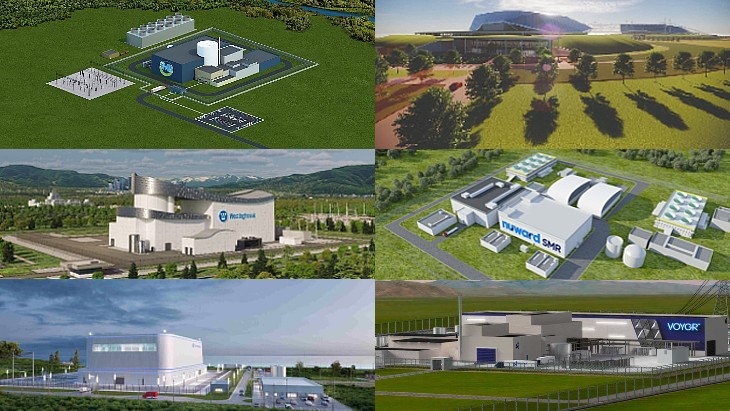In an interview with World Nuclear News, Bowen said that Great British Nuclear (GBN), the arms-length delivery body for the UK's new nuclear programme, was "in the final stages now of preparing, and getting the approvals for, the invitation to submit an initial tender document".
The UK government aims to quadruple nuclear energy capacity to 24 GW by 2050, with a contest launched last year to select which SMR technology to back. In October, a shortlist of six companies was drawn up - EDF, GE Hitachi Nuclear Energy International LLC, Holtec Britain Limited, NuScale Power, Rolls-Royce SMR and Westinghouse Electric Company UK Limited.
Bowen said that after the companies submit their responses to the tender, the intention was to shorten the list to around four, with the goal of placing contracts later this year, through to a final investment decision in 2029. He said: "My focus is absolutely on pace, because we need to move quickly from an energy security point of view and from an international market point of view, but what I'm not prepared to do, from the GBN board perspective, is trade pace for rigour."
He said that the tenders were for co-funding the technology all the way through to completion of the design, regulatory, environmental and site-specific permissions process, and the potential to place a contract for the supply of equipment. The documentation says between one and four technology providers could be selected, although Bowen said that two or three would be the "optimum number ... we will be retaining our optionality and there are some important conversations for us to have with government and the Treasury to determine what in the policy space they they are prepared to support".
The aim is "to have identified and acquired access" to a site for each of the selected technology at the time that contracts are signed, which is intended to happen later this year. Development companies would also need to be established for each site. These development companies would likely be established by GBN and would take forward all the regulatory and permissions required, as well as construction and then onto operations. "These are massive undertakings ... about the size of a FTSE100 company".
Each site selected "will have the scale to be able to build multiple SMRs of that technology at that site, so the likelihood is it will be one, two or three in the first stage but then being very clear that if these are successful, as we hope they will be, and they can demonstrate that their costs are going to come down with the second, third and fourth units, and we can convince ourselves it's value for money, then we want to just continue building on those sites. As we've learned internationally, that is the right thing to do."
He added: "So our current view, and again subject to the final stages approval, is that we will be placing contracts for more than one because what we have to demonstrate is that modularisation works and therefore the investment that is required to build the modular factories. So what we're saying is somewhere between two and three is what would be the first contract. And then depending on the success of that first project, which would be two to three reactors, then we would roll out more at that same site."
Alongside the UK government publishing its roadmap plan on how to get to 24 GW capacity by 2050, it also published a consultation of siting and on alternative routes to market for new nuclear.
Bowen said that at the moment the focus was on the eight existing sites earmarked for nuclear and "we are looking now at acquiring access for the SMR programme to Oldbury, Wylfa, Heysham, Hartlepool and the other sites within the existing policy statement". "Those are recognised nuclear sites which we can build on at scale - the SMR programme is all about scale."
But he said that to get to 24 GW those sites "are simply not going to be enough because we live on a small island and we've got to have much more flexibility about the sites that we have access to and indeed we have to allow the market to have access to the sites so we are no longer looking at, or, as the consultation is suggesting, that we should no longer be looking at the designation of sites, we should be looking at a criteria-based model which allows the developers to identify the sites and the usages they think they need".
As an example, he suggested that once there were advanced modular reactors that were officially designated "passive safety approved, walk-away safe" with smaller planning zones in a different regulatory regime, a much broader range of sites would become available.
On encouraging private sector-led projects, he said that when establishing GBN "the very clear advice from the UK around the world was that you really do need a government programme, a government-led programme, an underwritten programme, to rejuvenate the nuclear industry and get it started again - that doesn't for one minute preclude private developers developing their own projects, and we would want to encourage it".
Bowen, who also welcomed the cross-party consensus on new nuclear in what is likely to be an election year, said that the government's roadmap was an "overwhelmingly positive document" in restating the case for 24 GW by 2050, as well the ambition to do by adding 3 GW-7 GW every five years from 2030 to 2044, plus the commitment to a further large-scale plant after Hinkley Point C and the proposed new Sizewell C plant - "there is no way that we're going to get to 2050 and 24 gigawatts without the whole range and scales of reactors".
Listen and subscribe on all major podcast platforms
World Nuclear News podcast homepage
Spotify
Apple
Amazon Music
Google
Stitcher
Castbox
Episode credit: Presenter Alex Hunt. Co-produced and mixed by Pixelkisser Production






_63865.jpg)
_18570.jpg)
_16159.jpg)



